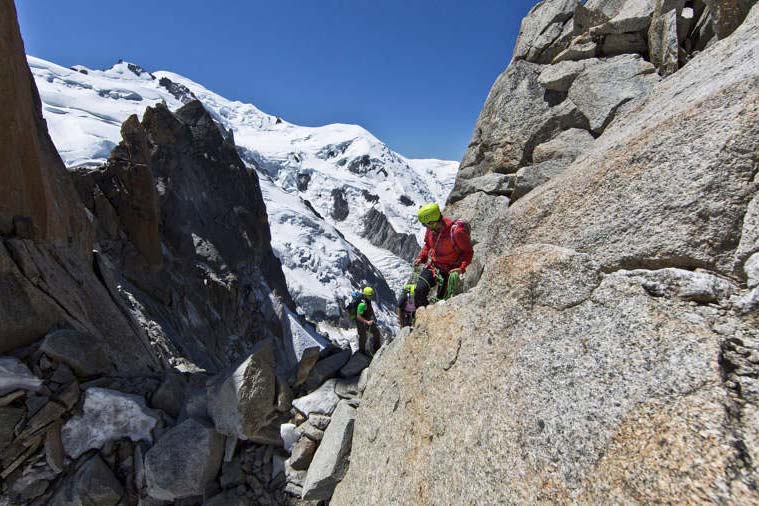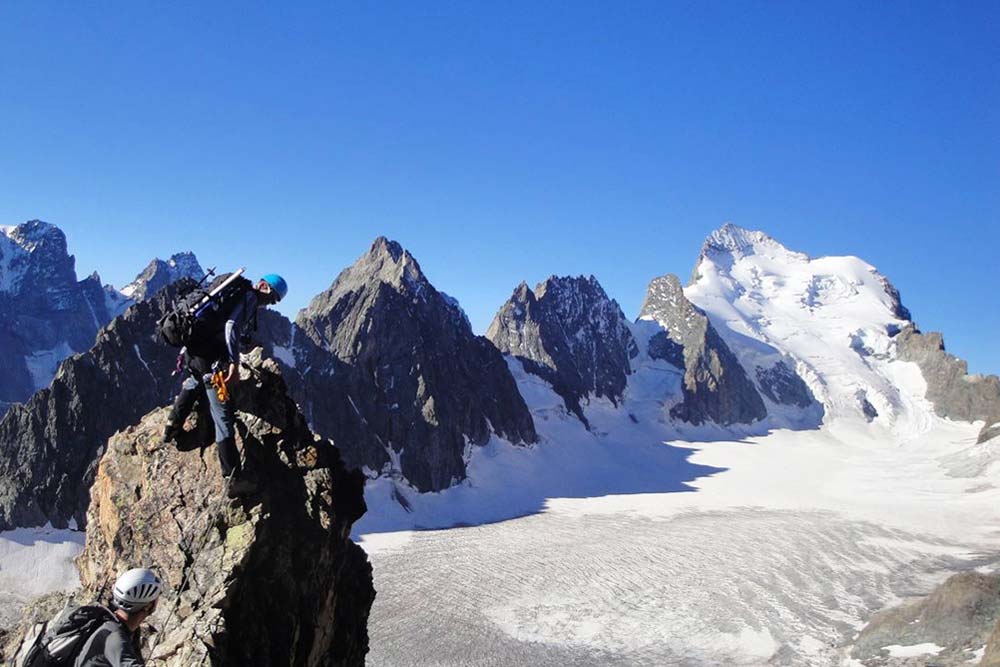
French Alps Mountaineering Guide
There are 82 peaks over 4000 m in the Alps and with the Massif du Mont Blanc and the Massif des Ecrins within its borders, France has more than its fair share of them. Add to to that the Ecrins, Vanoise and Mercantour national parks and the number of possible 3000 m+ mountaineering routes is mind boggling. We’ll cover some of the very best climbs, including classics like the Mont Blanc and the Grandes Jorasses and lesser known ascents like the Barre des Ecrins and the Dôme de Neige.
We’ll use the Alpine rating system that is increasingly becoming the global standard. It considers the overall difficulty of the complete route based on all factors of the final approach, ascent and descent, including length, altitude, danger, commitment, and technical difficulty.
Book a Mountaineering Trip
Our Mountaineering Guiding partners offer trips tailored to your experience, fitness and climbing ability. If you’re a passionate climber and dream of conquering an Alpine summit, it’s a really good idea to employ a high altitude mountain guide. All the companies listed here use fully qualified UIAGM mountain guides. They’ll be able to vary the route and rate of ascent to your ability, navigate in bad weather and keep you safe on steep snow and ice. Take a guide, you’ll be safer and you’ll have a lot more fun.
[sabai-directory category=mountaineering featured_only=1 hide_nav=1]
Mont Blanc Massif Mountaineering

Climbing the mighty Mont Blanc | © brey-photography.de
At 4810 m, the Mont Blanc is Western Europe’s highest mountain and a huge draw for mountaineers from around the world. Its glittering summit is visible for hundreds of kilometres in every direction. Every year thousands of mountaineers aspire to reach the summit and if you’re a passionate hill walker it’s a very achievable goal. But, although not technically difficult, you’re in a high mountain environment and you can’t underestimate the commitment required. You’ll need good endurance, to acclimatise well, and have the technical know-how to stay safe on steep ice. Despite its popularity, the Mont Blanc remains one of the world’s classic mountaineering acsents.
The Mont Blanc (4810 m) – Normal Route | Go >
Mountaineering holiday companies offer guided expeditions on the normal route of 2, 4, 5 and 6 days. A short 2-day trip will appeal if you’re an experienced climber, already acclimatised and just want to knock off the summit. The longer 5 and 6 day trips will include more acclimatisation and some technical crampon and ice-axe training for safety on steep ice. More days will also mean that your guide can be more selective with the weather window, increasing your chances of summiting on a clear day.
Aiguille Verte (4122 m) – Whymper Couloir
Legendary French alpinist and mountain guide Gaston Rébuffat famously said “Before the Verte you’re a climber, on the Verte you become a mountaineer”. His words have no doubt helped to forge the Aiguille Verte’s formidable reputation. In plain view from Les Praz village in Chamonix, the Aiguille Verte is one of the most beautiful mountains in the Mont Blanc Massif and indeed the Alps.
First climbed in 1865 by British climber Edward Whymper and his guides Christian Almer and Franz Biner, the route they pioneered now known as the Whymper couloir remains today, 146 years later, the ‘normal’ route for reaching the summit.
Grandes Jorasses (4208 m) – The North Face
The north face of this jagged 4000 m ridge straddling France and Italy is considered one of the 3 epic north face climbs of the Alps, along with the Matterhorn and the Eiger. It’s a gigantic and spectacular wall of rock, as beautiful as it is imposing and has become legendary amongst climbers. There’s 1200 m of sheer arête between the foot of the northern buttress (3010 m) to the highest point of the Grandes Jorasses (4208 m), known as Pointe Walker.
Ecrins National Park Mountaineering

Arete des Cineastes on the Barre des Ecrins | © odyssee-montagne.fr
Located just south of Les 2 Alpes and just west of Briançon, the Ecrins National Park in the southern French Alps is a stunningly beautiful and remote area of jagged peaks, Alpine meadows and glaciers. There are 2 peaks that capture the imagination of mountaineers – La Barre des Ecrins, the southernmost 4000 m peak in the French Alps, and La Meije, which at 3984 m is the second highest mountain of the Écrins.
Barre des Ecrins (4101 m)
Although not a technically difficult climb, the ascent requires solid high mountain experience, and a decent level of proficiency in crampons climbing rock and ice. Climbing expeditions will generally aim to complete the ascent in 4 days, spending a couple of days acclimatising and practising high mountain climbing techniques around the Glacier Blanc. Warm up climbs on Les Agneaux (3634 m) and the Pic du Glacier Blanc (3525 m) are possible with overnights in the Glacier Blanc or Écrins refuges. Tackling progressively more difficult climbs will get you up to speed both technically and physically ready to conquer the Barre des Écrins itself.
La Meije (3984 m)
The true summit of La Meije, the Grand Pic, is notoriously difficult and was the last major peak in the Alps to be summited. Commercial mountaineering expeditions usually summit the easier eastern peak. Trips generally take 5 or 6 days and involve some sport climbing and ice craft during the first couple of days to get you up to scratch for the ascent. A warm up climb on the straighforward Pic Nord des Cavales (3364 m) is also great for confidence building. Precariously perched at 3450 m is the Refuge de l’Aigle. Steeped in Alpine climbing history, it feels like a real privilege to spend the night. This is the jumping off point for a La Meije summit attempt.
